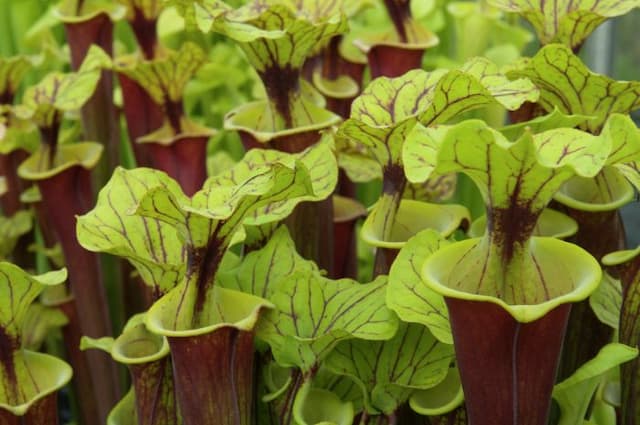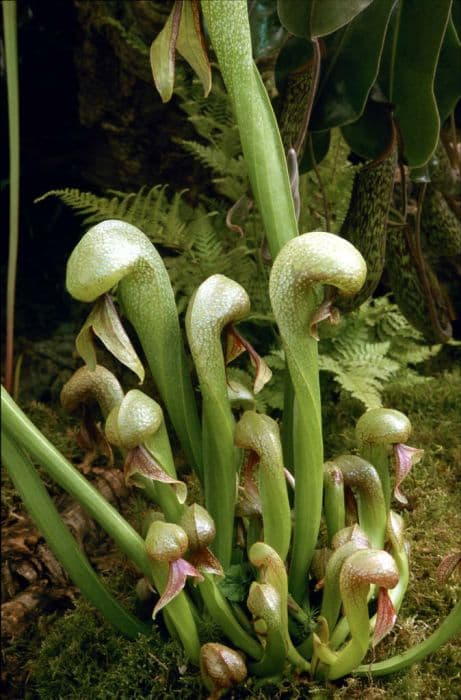Hybrid Pitcher Plant Sarracenia × excellens

ABOUT
The plant known as the pitcher plant has a distinctive appearance, characterized primarily by its elongated, tube-like leaves, which form the shape for which the plant is named. These modified leaves are known as pitchers, and they are designed to trap and digest insects. The pitchers often have a vibrant color palette, ranging from deep greens to brilliant reds, and they may exhibit veining or speckling, adding to their visual appeal. The top part of the pitcher is flared into a lid-like structure known as the hood, which helps protect the opening from debris while allowing insects to enter. Beneath the hood, the pitcher's inside surface is slippery, ensuring that insects that venture in for the nectar can easily slip down into the trap. At the bottom of this cavity, digestive fluids break down the captured prey, allowing the plant to absorb the nutrients. In addition to the pitchers, the plant produces flowers that stand out from the foliage. These flowers vary in color, often displaying shades of yellow, red, or green, and they have a unique, otherworldly appearance that can sometimes resemble an upside-down umbrella. While it is adorned with these conspicuous pitchers and peculiar flowers, the rest of the plant has a more subdued appearance, with foliage that may either blend into the background or provide a contrasting backdrop to emphasize the pitchers. The whole plant exudes an exotic and carnivorous allure, intriguing to both enthusiasts and casual observers alike.
About this plant
 Names
NamesFamily
Sarraceniaceae
Synonyms
Hybrid Pitcher Plant
Common names
Sarracenia × excellens.
 Characteristics
CharacteristicsLife cycle
Perennials
Foliage type
Deciduous
Color of leaves
Varies
Flower color
Varies
Height
2 feet (0.6 meters)
Spread
1 foot 6 inches (0.46 meters)
Plant type
Herb
Hardiness zones
6
Native area
Southeastern United States
Benefits
 General Benefits
General Benefits- Ornamental Value: Sarracenia × excellens adds aesthetic appeal to gardens with its unique pitcher-like leaves and attractive flowers.
- Insect Control: It is a carnivorous plant that traps and digests insects, helping to naturally reduce pest populations.
- Biodiversity Support: The plant provides food for a variety of specialized insects and other small animals that have adapted to live in and around the pitchers.
- Water Conservation: As a native of wetlands, Sarracenia × excellens can thrive in moist conditions without the need for frequent watering.
- Education and Research: It serves as an interesting subject for study in botany and ecology, helping to educate about carnivorous plants and their habitats.
- Habitat Creation: When grown in outdoor environments, it can contribute to creating microhabitats for various organisms.
- Garden Variety: It is a unique addition to a diverse garden, providing variety in form and function compared to other common garden plants.
- Conservation: Cultivating Sarracenia × excellens can aid in the conservation of carnivorous plant species, which are often threatened in the wild.
 Medical Properties
Medical PropertiesThis plant is not used for medical purposes.
 Air-purifying Qualities
Air-purifying QualitiesThis plant is not specifically known for air purifying qualities.
 Other Uses
Other Uses- Education and Research: The pitcher plant is often used in educational settings to teach about carnivorous plants and adaptation in plant species.
- Photography and Art: Its unique structure and appearance make it a popular subject for photographers and artists.
- Bioinspiration: The plant's trapping mechanism inspires materials scientists and engineers in designing new surfaces and adhesives.
- Garden Aesthetics: Owing to its striking appearance, the pitcher plant is cultivated for ornamental purposes in gardens and terrariums.
- Eco-Tourism: Areas where pitcher plants grow naturally may become sites for eco-tourism, attracting visitors interested in unique flora.
- Insect Control: Some gardeners use pitcher plants strategically to reduce the population of unwanted insects naturally.
- Competition Exhibits: Pitcher plants are sometimes featured in horticultural shows and competitions due to their exotic look.
- Conservation Awareness: The plant can be a flagship species for conservation efforts highlighting the importance of bog and wetland environments.
- Hobbies: Cultivating and hybridizing pitcher plants is a hobby for many enthusiasts who enjoy the challenge of growing them.
- Climate Change Studies: Scientists may study these plants to understand the impacts of climate change on carnivorous plant habitats and their survival.
Interesting Facts
 Feng Shui
Feng ShuiThe Sarracenia is not used in Feng Shui practice.
 Zodiac Sign Compitability
Zodiac Sign CompitabilityThe Sarracenia is not used in astrology practice.
 Plant Symbolism
Plant Symbolism- Adaptation: The pitcher plant, including Sarracenia × excellens, is known for its unique adaptive mechanism to trap insects. Thus, it symbolizes the ability to thrive in difficult or challenging conditions by adapting.
- Nature's Balance: This plant symbolizes the balance in nature, as it contributes to the ecosystem by controlling insect populations.
- Attraction and Deception: The pitcher plant's method of attracting prey with its colorful and deceptive structure represents themes of attraction coupled with deception.
- Uniqueness: With its distinct shape and trapping mechanism, the pitcher plant stands for the celebration of individuality and uniqueness.
- Patience: The pitcher plant waits patiently for its prey, and thus can symbolize patience in achieving one's goals.
 Water
WaterThe hybrid pitcher plant, Sarracenia × excellens, requires consistent moisture and should be watered with about one to two inches of water per week, ensuring the soil remains damp but not waterlogged. It's best to use distilled water or rainwater to avoid chemicals and minerals found in tap water, which can harm the plant. During the growing season, from spring to fall, water more frequently to maintain the wet soil condition, checking every few days. In winter, you can reduce watering as the plant enters dormancy, but make sure that the soil does not completely dry out.
 Light
LightThe hybrid pitcher plant thrives in full sunlight, which means placing it in a spot that receives direct sunlight for the majority of the day. A south-facing window or a bright outdoor location where it can get at least six to eight hours of direct sunlight is ideal. Good light exposure is crucial for the plant to develop its characteristic vibrant colors and to ensure healthy growth.
 Temperature
TemperatureFor the hybrid pitcher plant, the ideal temperature range during the growing season is between 70°F and 90°F during the day and no lower than 50°F at night. They can survive short periods of temperatures as low as 20°F, but they should not be exposed to frost for prolonged periods. To simulate their natural environment, a slight drop in night-time temperatures can be beneficial.
 Pruning
PruningPruning the hybrid pitcher plant typically involves the removal of dead or brown pitchers and leaves to maintain its appearance and prevent potential fungal growth. This should be carried out in late winter or early spring just before new growth begins. Pruning is not frequently required and should be done carefully to avoid damaging the healthy parts of the plant.
 Cleaning
CleaningAs needed
 Soil
SoilThe best soil mix for Sarracenia × excellens, commonly known as the Hybrid Pitcher Plant, is a combination of 1 part peat moss to 1 part perlite or coarse sand, providing good drainage and aeration. The ideal soil pH for this carnivorous plant should be acidic, in the range of 4.0 to 5.0.
 Repotting
RepottingHybrid Pitcher Plants should be repotted every 2 to 3 years to refresh the soil and prevent compaction, ideally in the early spring before the growing season begins.
 Humidity & Misting
Humidity & MistingHybrid Pitcher Plants thrive best in high humidity levels, around 60-80%. It's essential to maintain a moist environment to replicate their natural bog habitat.
 Suitable locations
Suitable locationsIndoor
Ensure bright light, high humidity, use acid soil mix.
Outdoor
Full sun, moist soil, protect from winter cold.
Hardiness zone
6-8 USDA
 Life cycle
Life cycleThe plant Sarracenia × excellens, commonly known as the Pitcher Plant, begins its life as a seed which germinates in warm, moist soil conditions. Upon sprouting, the seedling develops small pitcher-shaped leaves to trap insects, drawing nutrients from its prey to supplement the poor soil in which it often grows. As it matures, the plant forms a rosette of larger, more elaborate pitchers with vibrant colors and intricate patterns to attract insects. During its growing season, the Pitcher Plant produces flowers on tall stalks that are pollinated by bees and other insects, resulting in the production of seeds. After pollination, the plant enters a period of dormancy, typically during colder months, where growth slows down significantly. With the return of warmer weather, the Pitcher Plant resumes active growth, completing its annual life cycle and potentially living for many years through this cyclical process.
 Propogation
PropogationPropogation time
Spring to Summer
Sarracenia × excellens, commonly known as the Pitcher Plant, is typically propagated through division, a popular method that is ideally performed in the early spring just before the plant's growth season begins. To propagate by division, carefully remove the Pitcher Plant from its pot and gently separate the rhizomes, making sure each division has at least one growth point. These divisions can then be potted in a mixture of peat and perlite, maintaining high humidity and ensuring that the soil remains moist but not waterlogged. Place the pots in a warm, sunny location, avoiding direct sunlight until the plants are established. Dividing Pitcher Plants in this manner allows for the successful propagation of mature plants, encouraging healthy new growth for the following season.









